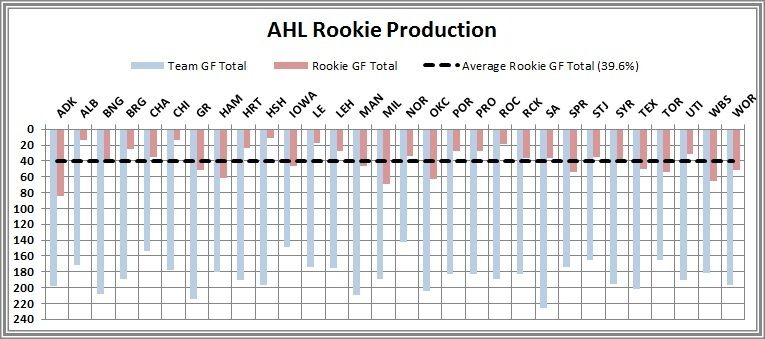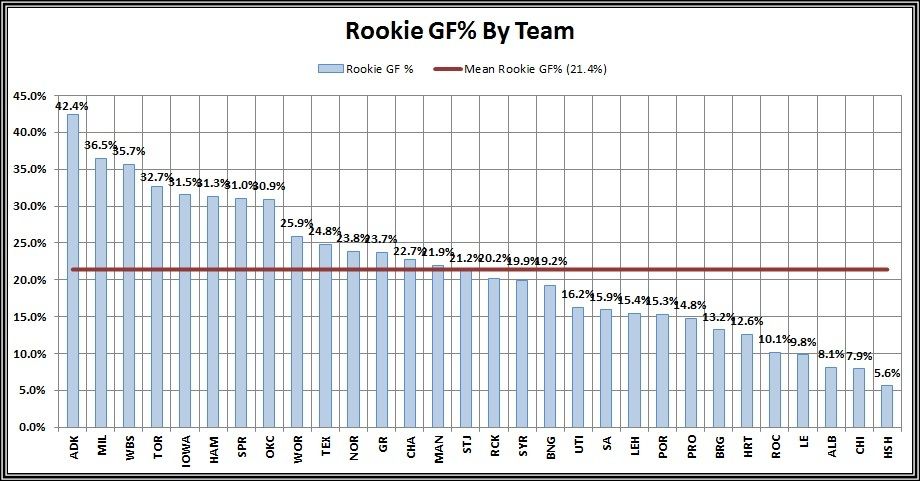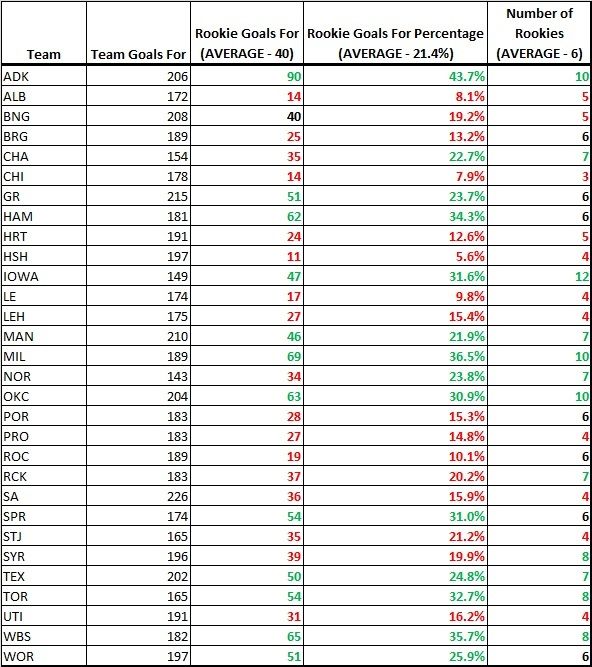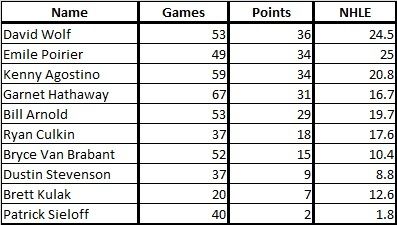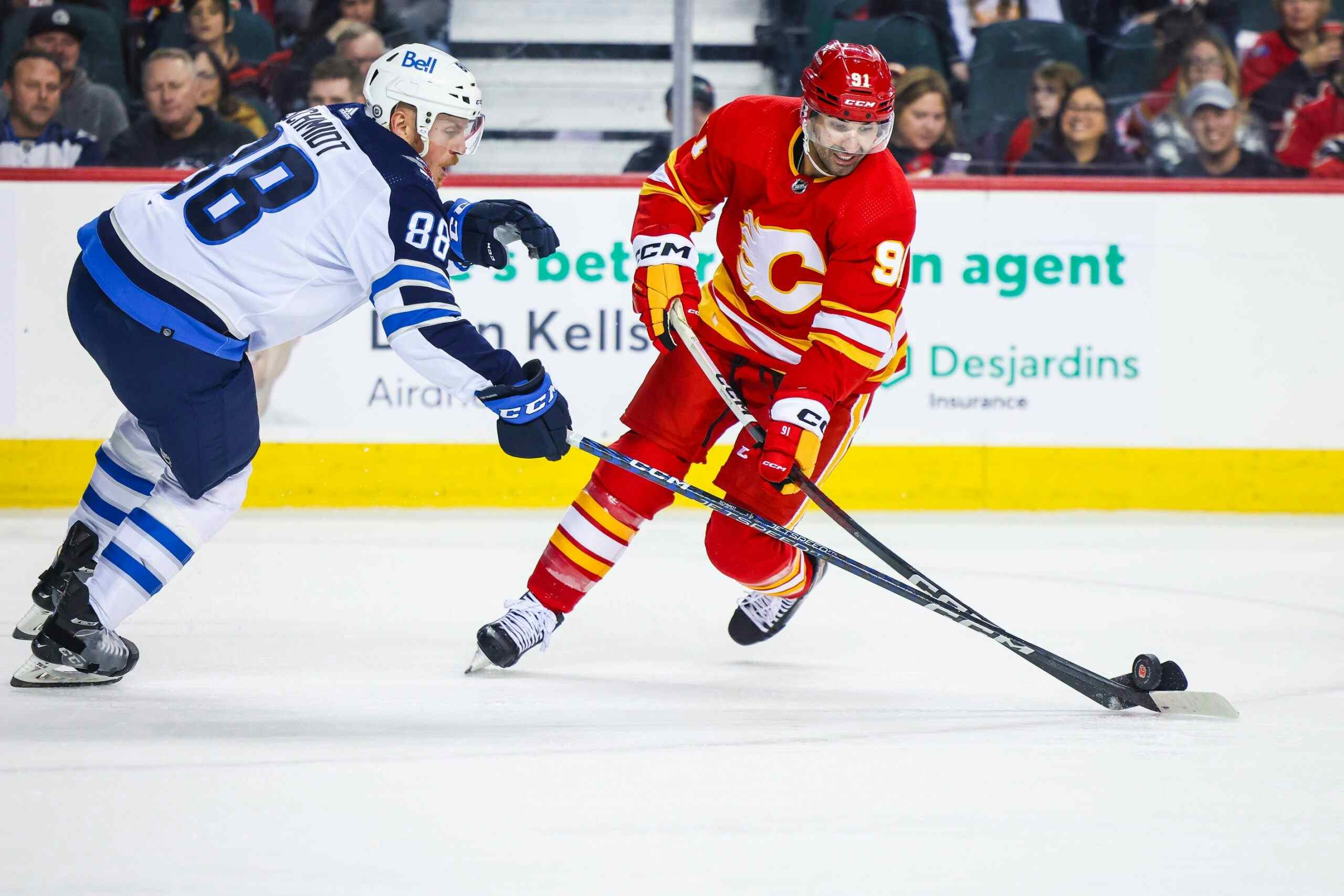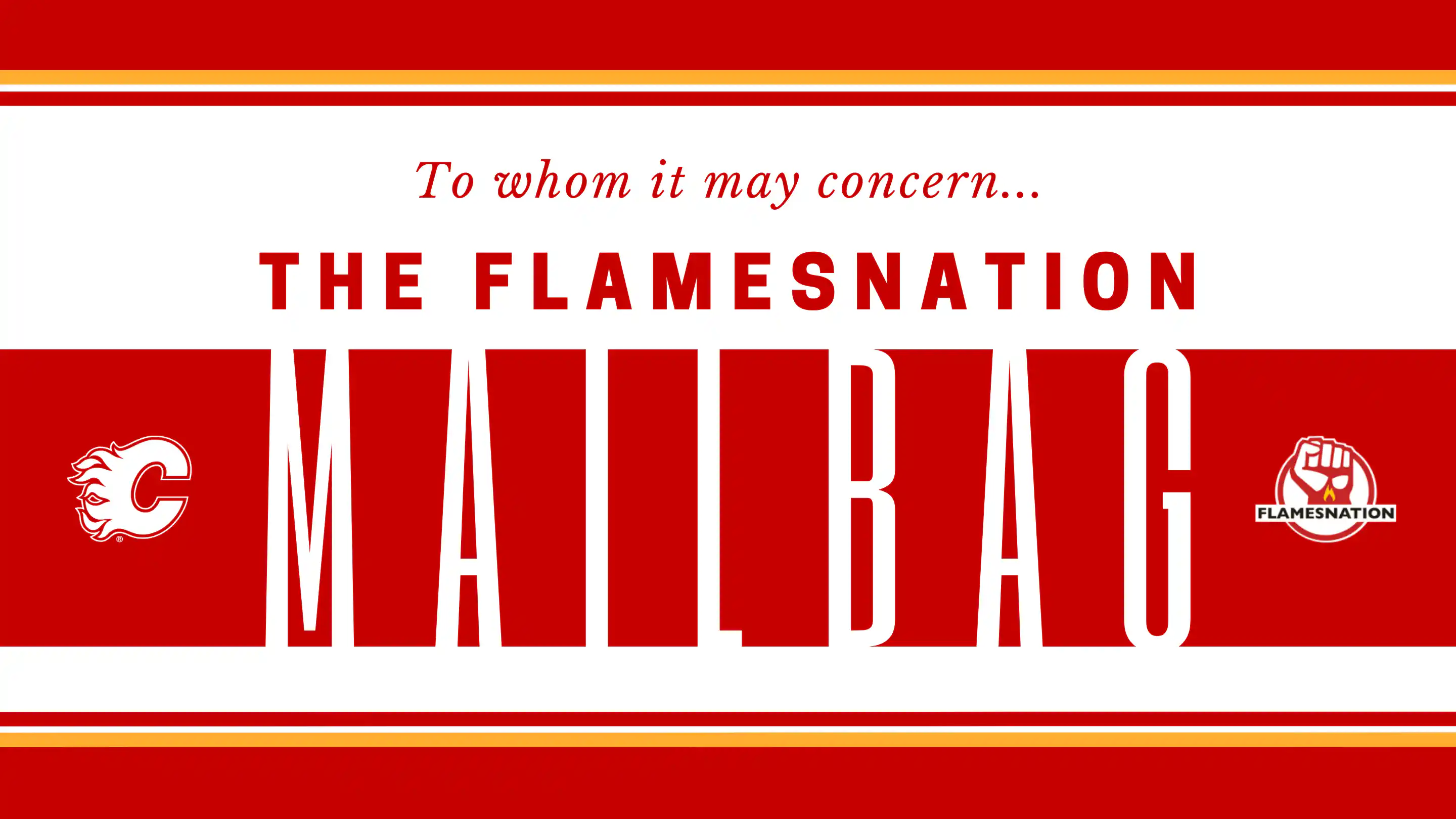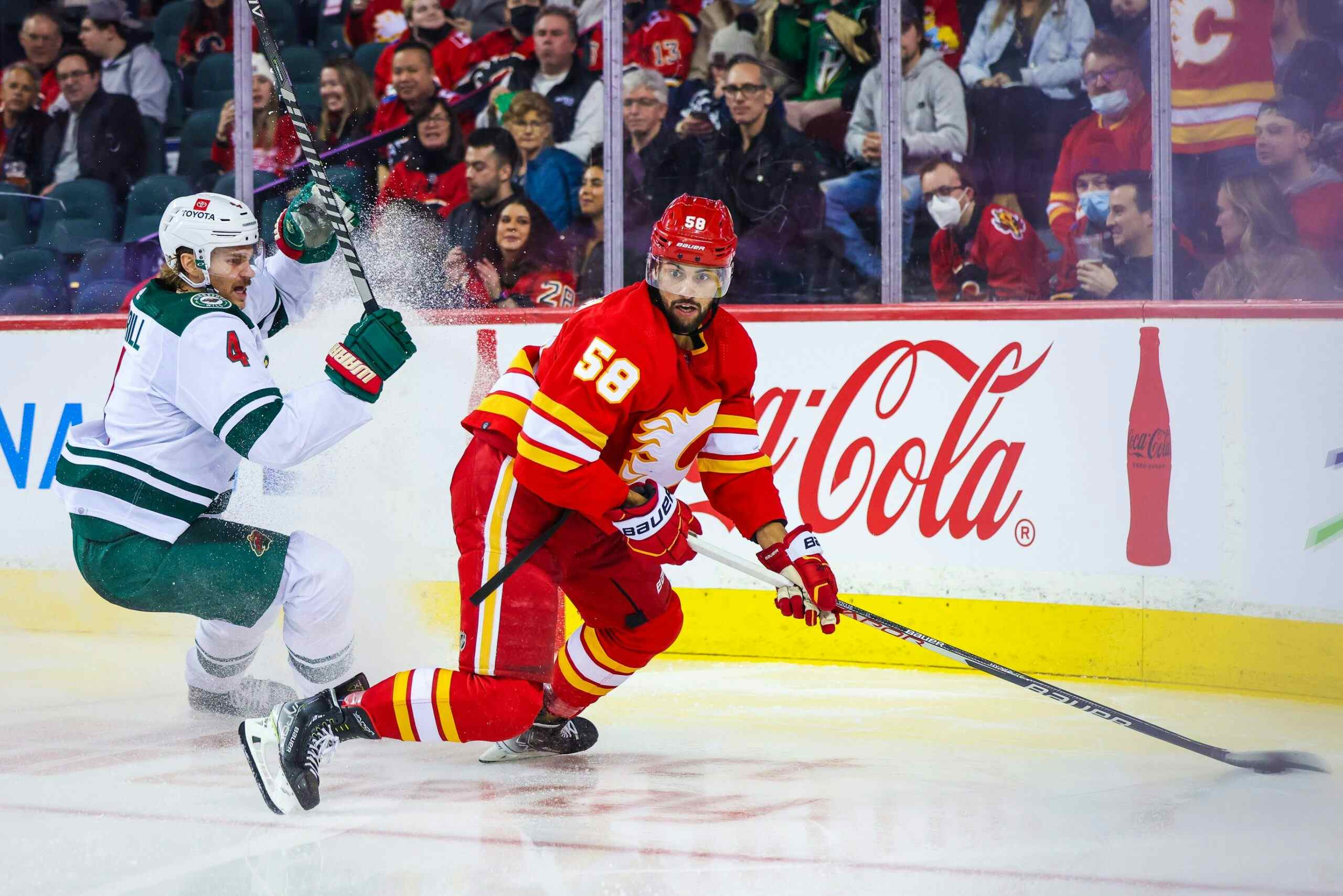Adirondack’s Rookie Pack Mules
These
truly are exciting times to be a Flames fan. That much is evident by simply
following this organization on a daily basis.
truly are exciting times to be a Flames fan. That much is evident by simply
following this organization on a daily basis.
Dig
even deeper though, and you’ll see that in terms of rookie production on the
farm, we haven’t seen anything like it in over a decade! That’s a really long time ago.
even deeper though, and you’ll see that in terms of rookie production on the
farm, we haven’t seen anything like it in over a decade! That’s a really long time ago.
Yes,
this season has been one for the ages for the Flames’ rookie pros where an
undrafted German import, an electric former first round pick, a college
standout, an undrafted Lance Bouma clone and Johnny Hockey’s ‘sidekick’ have
thrown the team on their back.
this season has been one for the ages for the Flames’ rookie pros where an
undrafted German import, an electric former first round pick, a college
standout, an undrafted Lance Bouma clone and Johnny Hockey’s ‘sidekick’ have
thrown the team on their back.
This team of rookie pack mules haven’t just
piled on goals at an extraordinary clip (see chart below), but a historical
clip as well, making them the most productive Flames’ AHL squad in the last decade.
piled on goals at an extraordinary clip (see chart below), but a historical
clip as well, making them the most productive Flames’ AHL squad in the last decade.
Please
keep in mind, the “Number of Rookies” in the above chart is only counting
rookies who played 10 games or more for the team in their respective season
(this is a way of ensuring that temporary ECHL/emergency call-ups aren’t
counted towards the total).
keep in mind, the “Number of Rookies” in the above chart is only counting
rookies who played 10 games or more for the team in their respective season
(this is a way of ensuring that temporary ECHL/emergency call-ups aren’t
counted towards the total).
Unlike
past seasons, it’s not just one or two rookies inflating the goals for
percentage. The scoring has been by committee. David Wolf leads the way with 19
goals, followed by Garnet Hathaway (19), Emile Poirier (17), Bill Arnold (12),
Kenny Agostino (12), and Bryce Van Brabant (8). Talk about balanced rookie
scoring.
past seasons, it’s not just one or two rookies inflating the goals for
percentage. The scoring has been by committee. David Wolf leads the way with 19
goals, followed by Garnet Hathaway (19), Emile Poirier (17), Bill Arnold (12),
Kenny Agostino (12), and Bryce Van Brabant (8). Talk about balanced rookie
scoring.
It’s
important to add context to these numbers though. In Abbotsford, there were
always veteran scorers to carry the load while the newbies learned the ropes.
But Adirondack doesn’t have a veteran core, per say. There is no Ben Street,
Corey Locke, Krys Kolanos, Ben Walter or Jason Jaffray. There are only rookies
playing big minutes against tough opponents in all situations; that’s what
makes this season extra special.
important to add context to these numbers though. In Abbotsford, there were
always veteran scorers to carry the load while the newbies learned the ropes.
But Adirondack doesn’t have a veteran core, per say. There is no Ben Street,
Corey Locke, Krys Kolanos, Ben Walter or Jason Jaffray. There are only rookies
playing big minutes against tough opponents in all situations; that’s what
makes this season extra special.
We
can’t downgrade the importance of veteran scoring in the AHL, but when it’s not
there it takes some mentally willful rookies to work through valleys in order to
get back to the peaks. It’s an interesting way to coerce rookies into a pattern
of consistent play. There’s no one to fall back on when times get tough. It’s
up to you and your equally as inexperienced teammates – and it’s worked out very well for Adirondack this season.
can’t downgrade the importance of veteran scoring in the AHL, but when it’s not
there it takes some mentally willful rookies to work through valleys in order to
get back to the peaks. It’s an interesting way to coerce rookies into a pattern
of consistent play. There’s no one to fall back on when times get tough. It’s
up to you and your equally as inexperienced teammates – and it’s worked out very well for Adirondack this season.
MEANWHILE,
ELSEWHERE IN THE AHL…
It’s
easy to look at Adirondack’s rookies and simply say, “wow, they’ve really drove
this team’s offense,” but until you take a snapshot of the other 29 teams and
how their rookies have been performing, the context really isn’t there.
Here’s your context:easy to look at Adirondack’s rookies and simply say, “wow, they’ve really drove
this team’s offense,” but until you take a snapshot of the other 29 teams and
how their rookies have been performing, the context really isn’t there.
Okay,
now pick your jaw up off your laptop.
now pick your jaw up off your laptop.
Let’s
look at the first chart. What we see is the total team’s goals for and each
team’s rookie goals for total. Only Milwaukee, Oklahoma City, Wilkes-Barre
Scranton and Hamilton’s rookies are somewhat close to Adirondack’s, but even
then, not really. Moreover, this is not a low-scoring team with highly
offensive rookies. Adirondack is near the top of the league in terms of total
goals for. They’re a high scoring team with high scoring rookies, nothing close
to what Flames observers thought would be the case entering the season.
look at the first chart. What we see is the total team’s goals for and each
team’s rookie goals for total. Only Milwaukee, Oklahoma City, Wilkes-Barre
Scranton and Hamilton’s rookies are somewhat close to Adirondack’s, but even
then, not really. Moreover, this is not a low-scoring team with highly
offensive rookies. Adirondack is near the top of the league in terms of total
goals for. They’re a high scoring team with high scoring rookies, nothing close
to what Flames observers thought would be the case entering the season.
The
second graph really drives the point home (please keep in mind, this chart was
updated prior to this weekend’s games. That number has risen since the chart
was made).
second graph really drives the point home (please keep in mind, this chart was
updated prior to this weekend’s games. That number has risen since the chart
was made).
Adirondack
is in a league of their own in terms comes to rookie scoring. With a full eight
points up on the Milwaukee Admirals, Adirondack will finish in the top their
class this season in this category (and there are still seven games to go!)
Perhaps the most striking part of their year is that they double (!) the league
average for rookie goals for percentage.
League-wide, there are an average number of six rookies on a team (see the chartis in a league of their own in terms comes to rookie scoring. With a full eight
points up on the Milwaukee Admirals, Adirondack will finish in the top their
class this season in this category (and there are still seven games to go!)
Perhaps the most striking part of their year is that they double (!) the league
average for rookie goals for percentage.
below). Again, I only included rookies that had played 10 games or more, which
essentially excluded ECHL emergency call-ups from counting towards the team
total. Adirondack has dressed 10 rookies who have played 10 games or more which
is tied for the second most in the league. Does this skew the data? Yes,
somewhat. Obviously Adirondack’s 10 rookies are likely going to score more
than, say, Hershey’s four rookies. This is why it’s important to measure the
percentage at which rookies contribute to their team’s total offense.
WHAT
ABOUT THEIR NHLE?
I’m
not going to describe to you all of the intricacies of NHLE because Justin
Azevedo over at Matchsticks
& Gasoline
did a nice job of that already.
not going to describe to you all of the intricacies of NHLE because Justin
Azevedo over at Matchsticks
& Gasoline
did a nice job of that already.
However,
like Justin mentioned in the above article, it is always important to consider context when looking at NHL
Equivalencies. A certain player could be lined up against horrible defensive
players, always start in the offensive zone, have an enormous amount of power
play time, and so on. If said player has 100 points in 70 major junior games,
an uneducated eye might think this a grade-A prospect, when really, he’d get
eaten up in the professional ranks.
like Justin mentioned in the above article, it is always important to consider context when looking at NHL
Equivalencies. A certain player could be lined up against horrible defensive
players, always start in the offensive zone, have an enormous amount of power
play time, and so on. If said player has 100 points in 70 major junior games,
an uneducated eye might think this a grade-A prospect, when really, he’d get
eaten up in the professional ranks.
rookie’s NHL Equivalencies (these are updated to April 3):
What
I said earlier about context, you can throw out the window when looking at the above
chart. All of these players, except for Bryce Van Brabant, Patrick Sieloff and
Brett Kulak have played in every
situation in hockey that you can imagine. These guys aren’t one-trick ponies.
Ryan Huska trusts them in every scenario, so given similar scenarios in the NHL this is fairly close to the kind of points you could expect from each of
these guys (if they were put into the NHL this season).
I said earlier about context, you can throw out the window when looking at the above
chart. All of these players, except for Bryce Van Brabant, Patrick Sieloff and
Brett Kulak have played in every
situation in hockey that you can imagine. These guys aren’t one-trick ponies.
Ryan Huska trusts them in every scenario, so given similar scenarios in the NHL this is fairly close to the kind of points you could expect from each of
these guys (if they were put into the NHL this season).
Keep in mind that with confidence, experience
and opportunity, these guys’ NHLE number will likely increase. It’s not out of
the question to see Poirier’s NHLE hit 40 next season, which would be a great
rookie year for him. David Wolf is the team’s heart that pumps blood to its
extremities, so if you give the German tank similar opportunities (which is
unlikely in the NHL), those are the sort of points you can expect. None of these guys except Poirier are expected
to become more than bottom-6 players in the NHL, so we probably won’t see them
in the dying minutes of the game or on the power play like we see them in the AHL.
Since this is the case, their true NHL point totals will be smaller than their
current NHLE (assuming these guys don’t evolve into superstars over the
summer).
and opportunity, these guys’ NHLE number will likely increase. It’s not out of
the question to see Poirier’s NHLE hit 40 next season, which would be a great
rookie year for him. David Wolf is the team’s heart that pumps blood to its
extremities, so if you give the German tank similar opportunities (which is
unlikely in the NHL), those are the sort of points you can expect. None of these guys except Poirier are expected
to become more than bottom-6 players in the NHL, so we probably won’t see them
in the dying minutes of the game or on the power play like we see them in the AHL.
Since this is the case, their true NHL point totals will be smaller than their
current NHLE (assuming these guys don’t evolve into superstars over the
summer).
SO
WHAT YOU’RE SAYING IS…
In
a year where Adirondack has four
players in the top 20 in AHL rookie scoring (Wolf, Poirier, Agostino and
Hathaway), it’s hard to say the season wasn’t a success. When you add to that
the sheer impact that their rookies have had on the total offense, it’s just
the whipped topping on the pumpkin pie.
a year where Adirondack has four
players in the top 20 in AHL rookie scoring (Wolf, Poirier, Agostino and
Hathaway), it’s hard to say the season wasn’t a success. When you add to that
the sheer impact that their rookies have had on the total offense, it’s just
the whipped topping on the pumpkin pie.
The
Flames are unlikely to make the playoffs, but that’s hardly an indicator of how
far the rebuild has come this season on the farm. When 10 rookies make up
nearly half of the team’s offense, you’ve got a successful season. Without
those rookies, the Flames would be in Iowa Wild territory.
Flames are unlikely to make the playoffs, but that’s hardly an indicator of how
far the rebuild has come this season on the farm. When 10 rookies make up
nearly half of the team’s offense, you’ve got a successful season. Without
those rookies, the Flames would be in Iowa Wild territory.
What this means for Brad Treliving and the big
club is the ever-important topic of organizational depth. Depth means that when
injuries occur in Calgary, their impact is lessened when a player can step in seamlessly.
Depth means trade chips. Depth means options. And right now, in terms of
impactful rookies, the Flames are deeper than they’ve been in decades.
club is the ever-important topic of organizational depth. Depth means that when
injuries occur in Calgary, their impact is lessened when a player can step in seamlessly.
Depth means trade chips. Depth means options. And right now, in terms of
impactful rookies, the Flames are deeper than they’ve been in decades.
Recent articles from Mike Cadarette


